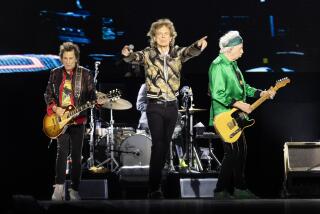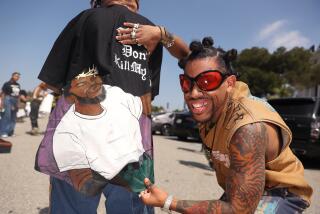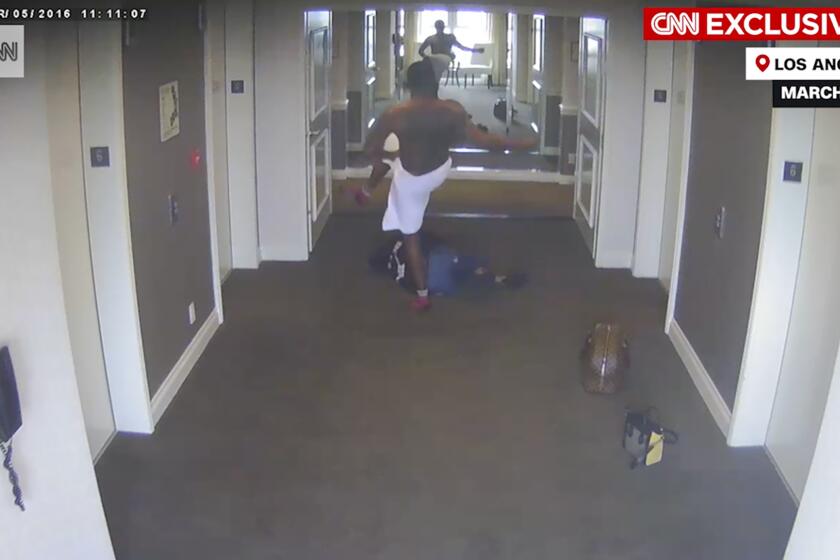COMMENTARY : Festival Falls Short of Defining a Generation : Pop culture: A few of the newer artists captured the spirit of the mostly young fans. But in the end, much of the contemporary vision was muddied.
SAUGERTIES, N.Y. — Twenty-five years after Woodstock, the festival’s most evocative image remains a young couple photographed while huddled tenderly in a blanket. The emerging symbol of Woodstock ’94 is a starker one: the Mud People.
Eager to assert their individuality in an ocean of anonymous concert-goers, about 200 fans early in the weekend began frolicking in cold, gooey mud. After the rain Saturday afternoon, they were joined in using mud as a badge of honor by the hundreds of fans in the “mosh pit”--the area in front of the main stage where young men dance to the music so aggressively that they look like footballers in a violent scrimmage.
Seizing on this emerging symbol, Trent Reznor and his band, Nine Inch Nails, came on stage Saturday night covered with mud themselves--a marvelous reminder of rock’s rebellious roots in a festival widely criticized for too many restrictions and too much commercialism.
But Reznor, one of rock’s most creative young talents, took the symbolism further, using it to give perspective and focus to the weekend.
Looking like a man relegated to the outskirts of society as he stood on stage caked in mud, Reznor dramatized brilliantly the frustration expressed by many of the young fans during the weekend. They are tired, they said in interviews, of their generation being characterized so frequently by media and parents as having little imagination or direction.
The brooding young man on stage, however, didn’t just rely on symbolism.
In a performance as captivating as the legendary ones from the original Woodstock, Reznor unleashed a grinding, yet melodic industrial rock sound that is more stark and less hopeful than the music of the late Kurt Cobain. Yet, like Cobain’s music, Reznor’s songs address the darkest uncertainties and fears of young people.
Looking down at the mosh pit, he good-naturedly said at one point between songs: “All you miserable, muddy f---heads are all right.”
The words were welcome and liberating for those in the audience that so much wanted this festival to step from the shadow of the original Woodstock, helping in the process to give their generation greater self-identity.
Too bad that so much of the rest of the weekend, musically speaking, seemed all wrong.
There were too few artists with the radical, contemporary vision of Reznor--someone who can address today’s Woodstock generation with the same eloquence and power that such artists as Jimi Hendrix, the Who, Creedence Clearwater Revival and Sly & the Family Stone brought to the original Woodstock.
Festival organizers did offer a healthy assortment of international acts on the smaller, south stage--among them the W.O.M.A.D. world music revue and a Jimmy Cliff-led reggae jam. The show’s preliminary bill on Friday did showcase contemporary bands, though the mediocrity of most of them was underscored by the elegance and ambition of the British band James.
But the heart of the show was defined by the performances on the huge north stage during the Saturday and Sunday shows, which were broadcast on pay TV--and far too much valuable time was turned over to ‘60s and ‘70s acts.
It’s one thing to build a bridge between the two Woodstocks, but this show was, in the words of its producers, designed for today’s Woodstock generation.
So why not give this generation its music?
Joe Cocker, the Crosby, Stills and Nash trio, the Allman Brothers Band and Traffic have all made valuable contributions to rock, but they shouldn’t have taken away hours of valuable time from the weekend. As the most important songwriter of the ‘60s, Bob Dylan, who was in Sunday’s cast, was the most fitting tie to the past and statement of the importance of rock history.
The suspicion is that the emphasis on older artists was, in part, an attempt to attract older viewers for the telecast and upcoming album and film. That thinking could backfire because older fans aren’t likely to have much interest in Nine Inch Nails (though they should) or such other young hotshots as Metallica, the Red Hot Chili Peppers, Cypress Hill and the Rollins Band. Similarly, the absence of more of today’s top contemporary bands is likely to leave young fans with too little to prize.
What we are left with in Woodstock ’94 is a $30-million festival, complete with magnificent sound and evidence of much care for the comfort and safety of the audience.
But its soul came from the energy and spirit of the audience and its nourishment chiefly from the vision of Trent Reznor and a few other contemporary groups. In the end, there simply wasn’t enough of that contemporary vision. When the mud is washed away, Woodstock ’94 may be remembered most as a lost opportunity.
* Times Link: 808-8463
To hear interviews with original Woodstock performers, music from Woodstock and readers commenting on what Woodstock means to them, call TimesLink and press *1969
Call TimesLink from area codes 213, 310, 714, 818 or 909. From other regions, use the area code nearest you.
More to Read
The biggest entertainment stories
Get our big stories about Hollywood, film, television, music, arts, culture and more right in your inbox as soon as they publish.
You may occasionally receive promotional content from the Los Angeles Times.










